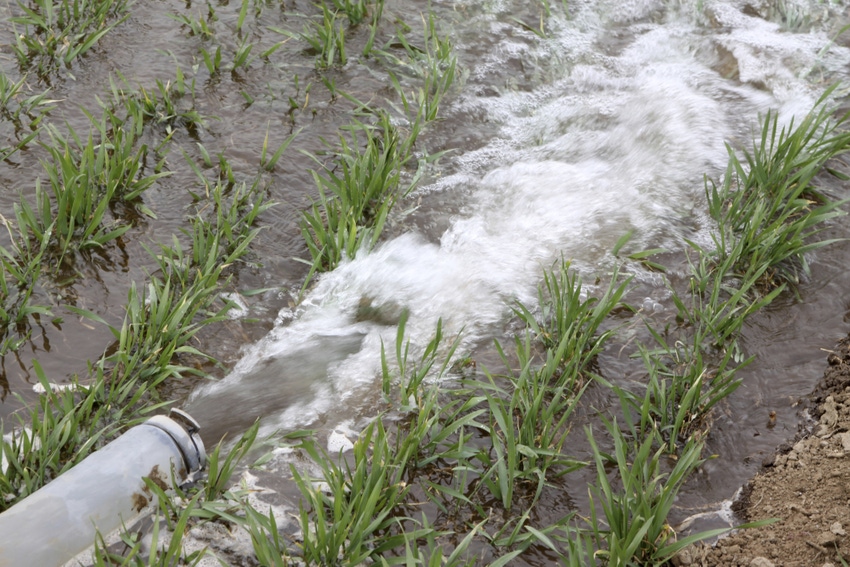Discarded mining byproducts act as primary filtering agent to remove phosphorus from municipal and ag wastewater.
July 19, 2017

A tabletop water filter demo designed to remove phosphorus from wastewater has, in five years, grown into a fully functional water treatment system capable of filtering more than 100,000 gal. per day.
Designed by a small U.S. Geological Survey (USGS) team, this cost-effective and environmentally friendly water filter system uses discarded mining byproducts, called mine drainage ochre, as the primary filtering agent to remove phosphorus from municipal and agricultural wastewater.
Even though phosphorus is a vital nutrient for humans, animals and crops, it can cause problems in watersheds. Dietary phosphorus that animals and people consume is excreted into wastewater, where it can accumulate and feed cyanobacteria, spawning harmful algal blooms.
Harmful algal blooms are an explosion in algae growth and are fueled by excess nutrients in the water, like phosphorus and nitrogen. The blooms can cause thick mats to accumulate on the surface of water and can deplete water oxygen concentrations, creating hypoxic "dead zones" responsible for fish and shellfish deaths, USGS said. Some species of algae can even create a variety of toxins that are harmful to people and wildlife.
“Harmful algal blooms are a worldwide problem,” said USGS engineer Philip Sibrell, lead designer of the filter. “Since phosphorus is one of the main drivers for freshwater blooms, being able to remove it from wastewater has some real promise for being able to reduce the ecological impacts arising from harmful algal blooms.”
Over the past few years, researchers have made a lot of progress on the filter system at the USGS Leetown Science Center, where it was developed. The team is now ready to take the filter out of the laboratory and put it to public use.
“We are at the point now where this filter system could support a small town, maybe around 1,000 people,” Sibrell said. “Finding cooperators willing to work with us and incorporate this technology will allow the system to continue to grow in size and improve over time.”
The USGS mine drainage ochre phosphorus filter system has been in the making for a long time. While the first filter prototype was built as a demonstration in 2012, USGS scientists began researching mine drainage ochre as a possible agent to remove phosphorus from water in 1999.
While current wastewater phosphorus removal systems are effective at removing the nutrient from water, they are expensive and have some problems that the USGS phosphorus filter was designed to overcome.
The USGS phosphorus filter is constructed with large tanks that each hold around 600 lb. of granular mine drainage ochre. It uses a gravity flow process where the phosphorus-infused water is piped to the top of the tank, allowing it to pass through the porous ochre media, and the filtered water is released out of the bottom of the tank.
The simple design of the USGS phosphorus filter and the fact that it uses mine drainage ochre as a filtering agent keeps the costs down for any water treatment facility that considers using this technology.
“Every component of the water treatment system was purchased as commercial, off-the-shelf items,” Sibrell said. “Nothing was special ordered, and nothing was custom fabricated, which really helped us keep the costs down.”
In addition to the simple design and economic advantages of using mine drainage ochre byproducts as the filtering agent, the USGS phosphorus filter also has the added bonus of addressing the serious problem of acid mine drainage.
Acid mine drainage occurs when certain minerals in the ground — like pyrite or other sulfide minerals — are disturbed by mining, digging and excavating, exposing these minerals to air and moisture. When this happens, it causes a chemical reaction in the sulfide minerals that creates sulfuric acid and a variety of dissolved heavy metals.
Because of these heavy metals, not all mine drainage ochres are suitable for use as a phosphorus filtering agent, because some have the potential to contaminate the treated water, USGS said. Therefore, the ochres used in the USGS phosphorus filter have been sourced from coal mine drainages, which usually results in lower levels of toxic metals like copper, lead and arsenic. Water that has been treated by these coal mine drainage ochres have been laboratory tested, and scientists have confirmed that heavy metals are not present in the filtered water in detectable amounts.
In addition to providing a use for the acid mine drainage byproduct, the systems also has the potential to be another source of phosphorus. During the filtering process, once the mine drainage ochre becomes saturated with phosphorus, the phosphorus can be stripped off of the ochre, regenerating the media to be used again and recapturing the phosphorus to be recycled.
“The world relies on high-phosphorus fertilizers for food production, and many deposits of this vital mineral are becoming depleted,” Sibrell said. “Because of that, the ability to recover the phosphorus from the ochre is a big deal, allowing us to close the recycling loop by reusing both the ochre and phosphorus again.”
For more information on using mine drainage ochre byproducts to remove phosphorus from water, click here.
You May Also Like


.png?width=300&auto=webp&quality=80&disable=upscale)
